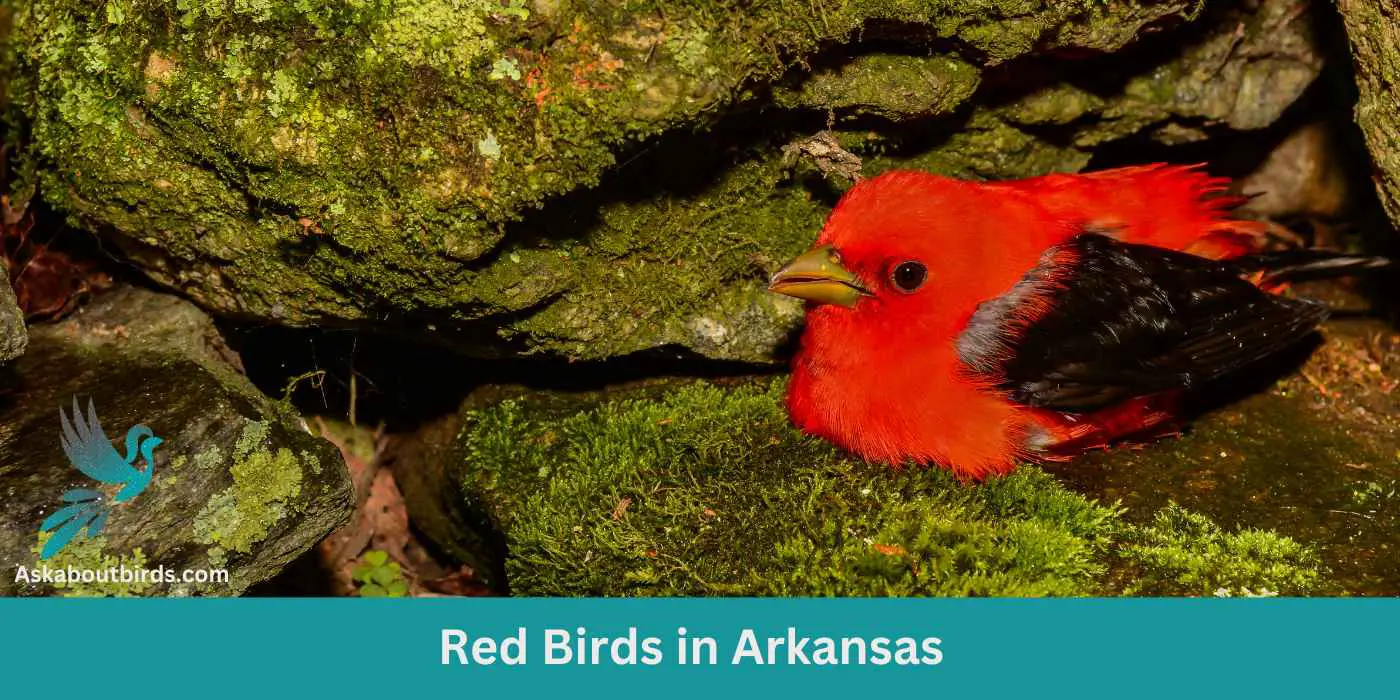Experience the vibrant avian tapestry of Arkansas with our guide to 11 resplendent red birds. Arkansas, being part of the Mississippi Flyway, is a haven for various bird species, including several that have red or partly red plumage.
From the charming Northern Cardinal to the occasional Pine Grosbeak, the Natural State is a treasure trove of crimson-feathered wonders. To enrich your birdwatching journey, we’ve paired this guide with stunning photos, offering a vivid glimpse into the heart of Arkansas’s birdlife.
Red Birds Found In Arkansas
The diverse topography of Arkansas, ranging from the rugged terrain of the Ozark and Ouachita Mountains to the fertile plains of the Mississippi River Delta, provides a myriad of habitats that cater to a broad spectrum of bird species. This variety in landscape, combined with its position within the Mississippi Flyway—a major bird migratory route—ensures that Arkansas sees both resident birds and a multitude of migratory species passing through.
Northern Cardinal


| Feature | Measurement |
|---|---|
| Scientific Name | Cardinalis cardinalis |
| Length | 8.3 – 9.1 in |
| Wingspan | 9.8 – 12.2 in |
| Weight | 1.19 – 2.29 oz |
The Northern Cardinal is an iconic North American bird, easily recognized by its vibrant color and melodious song.
Appearance: Male Northern Cardinals are a brilliant scarlet red, while females display a more subdued reddish olive. Both sexes have a distinctive black ‘mask’ on their face around the bill and a pointed crest on their head. The bird’s beak is robust, cone-shaped, and bright orange in color.
Diet: Northern Cardinals are primarily granivorous, with a diet largely consisting of seeds and grains. They also eat fruits and insects. These birds typically feed off the ground and are frequent visitors to bird feeders.
Reproduction: Northern Cardinals are monogamous, and a pair will breed together for life. The female typically builds a well-hidden nest in a dense thicket or shrub. She lays 2-5 eggs per clutch, which she incubates for around two weeks.
Summer Tanager


| Feature | Measurement |
|---|---|
| Scientific Name | Piranga rubra |
| Length | 6.7 in |
| Wingspan | 28 to 30 cm |
| Weight | 29 g |
The Summer Tanager is a medium-sized songbird admired for its radiant plumage and melodious song.
Appearance: Male Summer Tanagers are an impressive bright red, while females and juveniles present a softer, yellow-orange color. Both genders have a large, slightly hooked bill and relatively short tail.
Diet: Summer Tanagers primarily feed on insects, including bees and wasps, which they catch in flight or pick off vegetation. They are also known to eat fruits and berries, making them helpful in controlling pest populations and seed dispersal.
Reproduction: The female Summer Tanager builds a loose, shallow cup-shaped nest out of twigs and grass, usually hidden in the foliage of trees. The female typically lays 3-5 eggs, which she will incubate for about two weeks.
Scarlet Tanager


| Feature | Measurement |
|---|---|
| Scientific Name | Piranga olivacea |
| Length | 6.3 to 7.5 in |
| Wingspan | 9.8 to 11.8 in |
| Weight | 23.5 to 38 g |
The Scarlet Tanager is a strikingly colorful bird known for its brilliant plumage and distinctive song.
Appearance: Male Scarlet Tanagers are notable for their vibrant scarlet bodies contrasted with black wings and tail, making them one of the most intensely colored birds. Females and juveniles, on the other hand, have a subdued olive-yellow body color with darker wings and tail.
Diet: The diet of the Scarlet Tanager is largely made up of insects, including beetles, cicadas, aphids, and others. They are adept flycatchers, seizing insects in mid-air or picking them off foliage. They also consume fruits and berries, especially during migration and in their winter habitats.
Reproduction: The female Scarlet Tanager builds a cup-shaped nest using twigs, rootlets, and grass, typically well-hidden in the dense foliage of trees. She lays 3 to 5 eggs and incubates them for about two weeks.
Red-headed Woodpecker

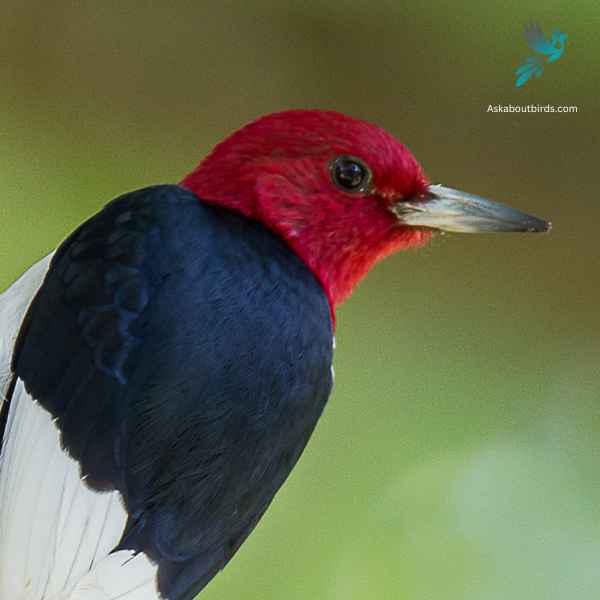
| Feature | Measurement |
|---|---|
| Scientific Name | Melanerpes erythrocephalus |
| Length | 7.5–9.1 in |
| Wingspan | 16.5 in |
| Weight | 2.0–3.2 oz |
The Red-headed Woodpecker is a striking forest bird with a bold tri-colored pattern.
Appearance: This woodpecker features a completely red head and neck, contrasting starkly with its white underparts and black wings. Its wings also have large white patches which are conspicuous in flight.
Diet: Red-headed Woodpeckers have a varied diet including insects, seeds, fruits, berries, and occasionally even the eggs of other birds. They’re also known to store food by wedging it into crevices in bark.
Reproduction: These woodpeckers nest in cavities which they excavate in dead wood or dead parts of live trees. These cavities can be found anywhere from 2 to 80 feet off the ground.
Red-bellied Woodpecker
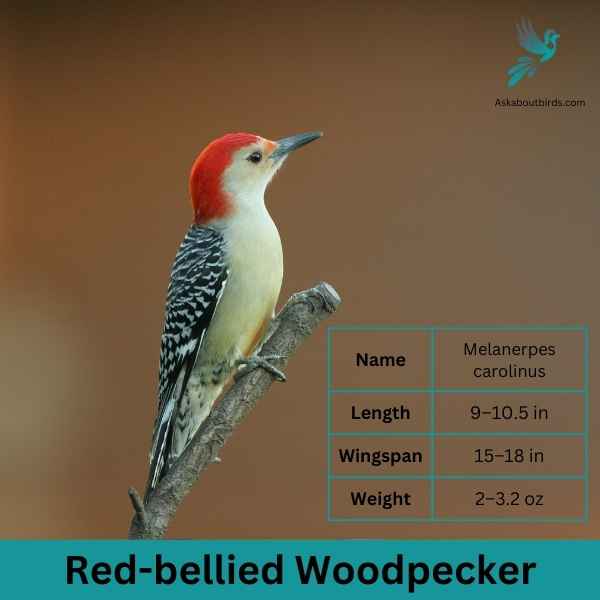
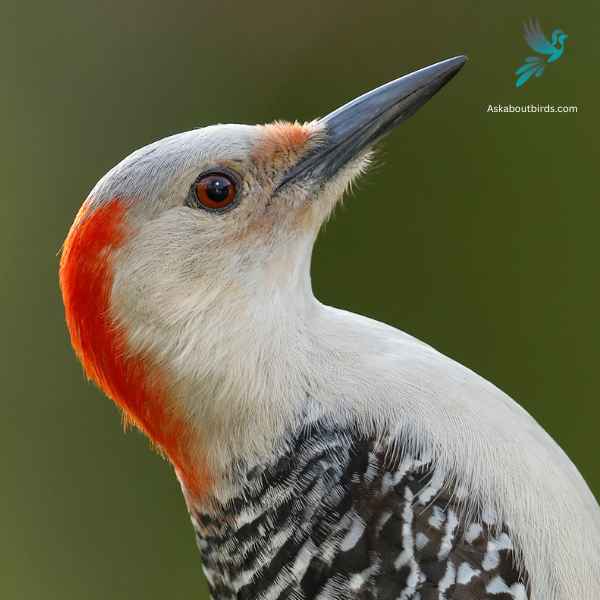
| Feature | Measurement |
|---|---|
| Scientific Name | Thryothorus ludovicianus |
| Length | 4.7–5.5 in |
| Wingspan | 11 in |
| Weight | 0.63–0.81 oz |
The Red-bellied Woodpecker is a medium-sized woodpecker commonly found in woodlands, forests, and backyards across the eastern and central U.S.
Appearance: The Red-bellied Woodpecker sports a pale gray face, throat, and belly, contrasted by a zebra-striped back. Its name derives from the subtle reddish tinge on its belly, but it’s more commonly recognized by the vivid red cap on the head of males and the partial red cap on females.
Diet: This woodpecker has a varied diet that includes insects, fruits, nuts, and seeds. They frequently forage on tree trunks and branches, using their sticky, barbed-tipped tongue to extract ants, beetles, and other insects from crevices.
Reproduction: Red-bellied Woodpeckers are cavity nesters, excavating holes in tree trunks for their nests. The inside of the nest is typically unlined or sparingly lined with wood chips.
Red Crossbill
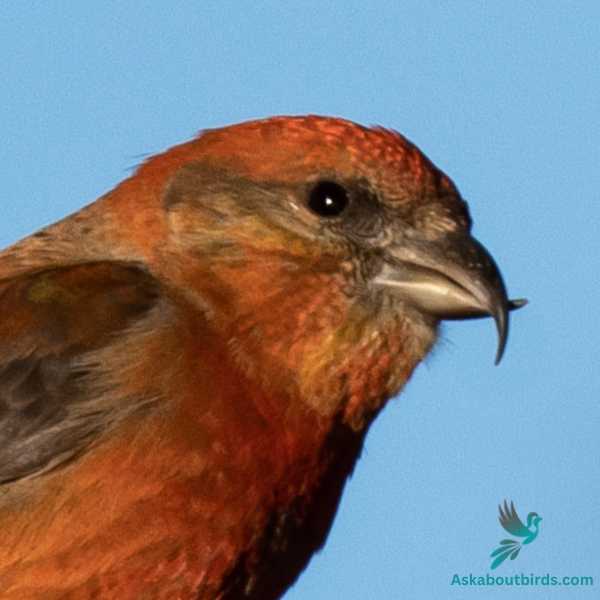

| Feature | Measurement |
|---|---|
| Scientific Name | Loxia curvirostra |
| Length | 20 cm |
| Wingspan | 27–29 cm |
| Weight | 40-53 g |
The Red Crossbill is a peculiar bird species, celebrated for its unique beak structure and vibrant coloration.
Appearance: Red Crossbills are named for their distinctive crossed mandibles, which are adapted to extracting seeds from conifer cones. Male Red Crossbills are usually bright red or orange, while females and juveniles are greenish-yellow. All have dark wings and notched tails.
Diet: The diet of the Red Crossbill is primarily composed of conifer seeds, their unique beak allowing them to access these seeds with ease. This diet includes seeds from pine, spruce, and other types of coniferous trees. They are also known to consume some insects.
Reproduction: Red Crossbills are known for their flexible breeding season, which can occur any time of the year when there is an abundance of food. They typically nest in conifers, where the female lays a clutch of 3 to 4 eggs.
House Finch


| Feature | Measurement |
|---|---|
| Scientific Name | Haemorhous mexicanus |
| Length | 5–6 in |
| Wingspan | 8–10 in |
| Weight | 0.6–0.9 oz |
The House Finch is a small songbird widely distributed across North America and is commonly found in urban and suburban areas.
Appearance: Males of this species are brightly colored with crimson faces and throats, which can extend to the chest and back, while their flanks have streaks. The female is streaked brown and lacks the red coloring. Both have a square-tipped tail and a distinctively long, flat-topped bill.
Diet: House Finches primarily eat seeds, grains, and berries. They have a particular fondness for sunflower seeds and can be commonly seen at bird feeders. Occasionally, they will also consume insects, especially during the breeding season.
Reproduction: House Finches are cavity-nesters and might choose ledges, vents, ledges, and other urban settings. They might also utilize trees or shrubs. Their nests can be made of a wide array of materials, from feathers to twigs.
Purple Finch


| Feature | Measurement |
|---|---|
| Scientific Name | Haemorhous purpureus |
| Length | 4.7–6.3 in |
| Wingspan | 4.7–6.3 in |
| Weight | 0.6–1.1 oz |
The Purple Finch is a vibrant songbird often mistaken for its close relative, the House Finch, but it exhibits a different hue and patterns.
Appearance: Males are raspberry red on the head, throat, and breast, with streaky brown backs and wings. The intensity of the red can vary among individuals. Females are brown and streaked all over but might show a slight blush on the face. They lack the strong facial patterns seen in female House Finches.
Diet: Purple Finches primarily consume seeds, with a preference for sunflower seeds, dandelion seeds, and buds. They also eat insects and berries, especially during the breeding season.
Reproduction: These finches often nest in conifers or mixed woodlands. The nest, typically located on a horizontal branch, is made from twigs and grass, then lined with feathers.
Rufous-sided (Eastern) Towhee
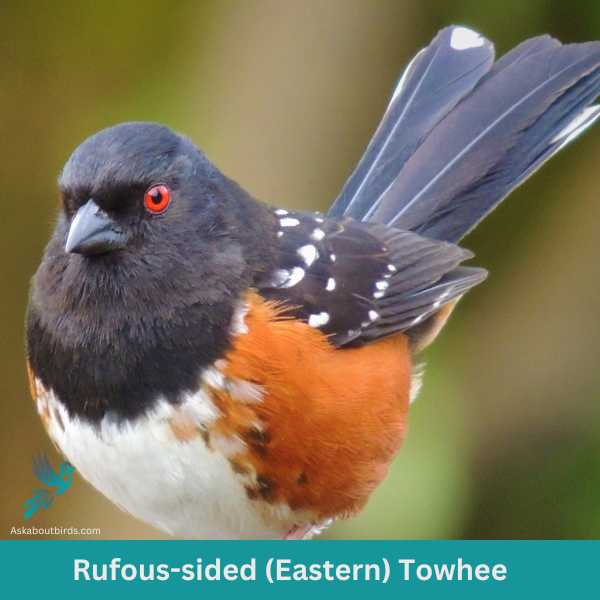
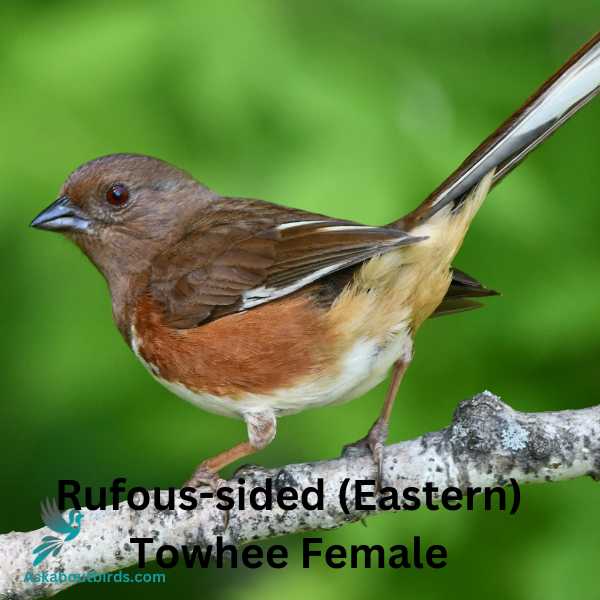
| Scientific Name | Pipilo erythrophthalmus |
| Length | 6.75 to 8.25 inches |
| Wingspan | 7.9 to 11 inches |
| Weight | 1.1 to 1.8 ounces |
The Rufous-sided Towhee, more commonly known as the Eastern Towhee, is a striking bird distinguished by its vivid coloration and melodious calls.
Appearance: Male Eastern Towhees are characterized by their black upper bodies, rufous flanks, and white underbellies. Females share the same pattern but are brown where the males are black. Both sexes have a distinctive red eye.
Diet: Eastern Towhees primarily feed on the ground, rummaging through leaf litter for seeds, berries, and insects. Their diet can vary seasonally, with more insects in warmer months and seeds during winter.
Reproduction: Eastern Towhees nest on or near the ground, typically in shrubs or dense vegetation. The female constructs the nest and incubates a clutch of 2 to 5 eggs, which hatch after about 12 days.
Red-Winged Blackbird
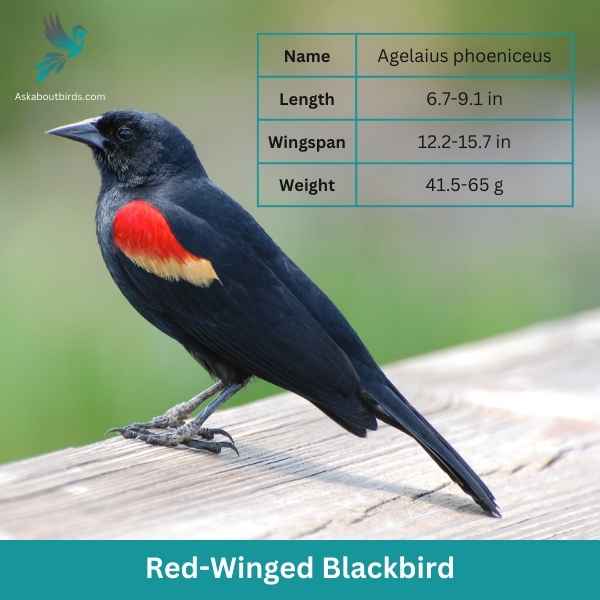
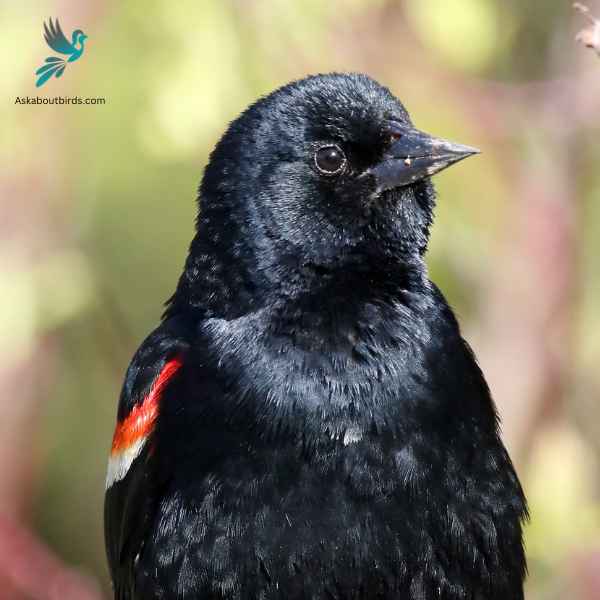
| Feature | Measurement |
|---|---|
| Scientific Name | Agelaius phoeniceus |
| Length | 6.7-9.1 in |
| Wingspan | 12.2-15.7 in |
| Weight | 41.5-65 g |
The Red-Winged Blackbird is a familiar sight across North America, especially in wetlands and open areas. Known for its striking coloration and distinct call, it is often seen perched on cattails or utility lines.
Appearance: Male Red-Winged Blackbirds are glossy black with bright red-and-yellow shoulder patches, while females are streaky brown, resembling a large sparrow. The males’ red patches become more prominent when they’re displaying or agitated.
Diet: Red-Winged Blackbirds primarily feed on seeds and insects. Their diet includes grains, sunflower seeds, and corn, but they also eat beetles, caterpillars, and other small invertebrates, especially in the breeding season.
Reproduction: Red-Winged Blackbirds nest in marshes, along watercourses, and in wet fields. The female constructs a cup-shaped nest using grass and sedge, attaching it to plants above water. She typically lays a clutch of 3 to 4 blue-green eggs, which she incubates for about 11-12 days. Males, being polygynous, often have multiple mates during a single breeding season.
Pine Grosbeak

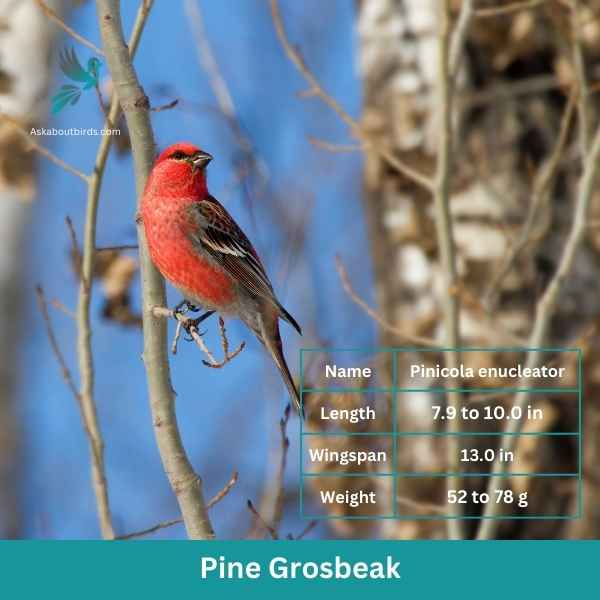
| Feature | Measurement |
|---|---|
| Scientific Name | Pinicola enucleator |
| Length | 7.9 to 10.0 in |
| Wingspan | 13.0 in |
| Weight | 52 to 78 g |
The Pine Grosbeak is a striking bird native to the northern regions of North America, often found in coniferous forests. Both males and females have a plump and robust body with a large beak adapted for eating seeds. The male Pine Grosbeak displays a vibrant reddish-pink plumage, while the female has a more subdued grayish-brown coloration.
These birds are typically seen in small flocks, foraging for food in trees and on the ground. They have a preference for seeds, particularly those from various conifer species. The Pine Grosbeak uses its strong bill to crack open the cones of tall trees and extract the seeds, but they also consume berries and small fruits when available.
Where to Spot Arkansas’ Red Birds
Arkansas’s varied landscapes serve as a backdrop to some of the nation’s most vibrant birdwatching locations. Here are the top havens in Arkansas where red birds and their avian companions flourish:
- Holla Bend National Wildlife Refuge: Nestled along the Arkansas River, this refuge boasts over 7,000 acres of wetlands and forests, offering sanctuary to migratory waterfowl and various songbirds, including many red species.
- Hot Springs National Park: Beyond its renowned thermal waters, this national park’s forested mountainsides create a natural sanctuary for a diversity of bird species, making it a popular spot for bird enthusiasts.
- Ozark National Forest: Spanning over a million acres, this forested expanse in northern Arkansas is home to diverse habitats, from hardwood forests to grassy glades, attracting a rich variety of bird species.
- Lake Chicot State Park: Located near the Mississippi border, this park centers around Arkansas’s largest oxbow lake, a magnet for waterfowl and woodland birds. The surrounding forests and wetlands provide ample opportunities for birdwatching.
- Buffalo National River: America’s first national river, this pristine waterway winds through the Ozark Mountains and offers a diverse range of habitats. The river’s shores and the surrounding woodlands host a myriad of bird species, including those with brilliant red plumage.
| State’s Red birds | Best Spots for Red Birds |
|---|---|
| Missouri’s Red birds | 1. Mingo National Wildlife Refuge 2. Mark Twain National Forest 3. Busch Conservation Area |
| Tennessee’s Red birds | 1. Reelfoot Lake State Park 2. Great Smoky Mountains National Park 3. Radnor Lake State Park |
| Mississippi’s Red birds | 1. Noxubee National Wildlife Refuge 2. St. Catherine Creek National Wildlife Refuge 3. Gulf Islands National Seashore |
| Louisiana’s Red birds | 1. Atchafalaya National Wildlife Refuge 2. Lake Martin 3. Kisatchie National Forest |
| Texas’s Red birds | 1. Big Bend National Park 2. Aransas National Wildlife Refuge 3. High Island |
| Oklahoma’s Red birds | 1. Wichita Mountains Wildlife Refuge 2. Salt Plains National Wildlife Refuge 3. Sequoyah National Wildlife Refuge |
FAQs on Red Bird Species Found in Arkansas
Which bright red birds are a common sight in the forest canopy of Arkansas?
In the forest canopy of Arkansas, bird enthusiasts commonly spot Summer Tanager males, known for their bright red plumage. Additionally, the Painted Bunting, particularly the males, showcases a rosy red plumage contrasted by bright greenish yellow and blue colors, making them a visual delight among the tree branches.
What attracts Painted Bunting males and other red birds to backyards in Arkansas?
Painted Bunting males and other red birds, like the Summer Tanager, are often attracted to backyards in Arkansas by bird feeders stocked with black oil sunflower seeds. These seeds are particularly enticing to a variety of wild birds, making them a popular choice for those looking to welcome a colorful array of avian visitors. Additionally, bird baths or sources of water can also be a magnet for these birds, especially during the warmer months.
Are Painted Buntings with bright yellow-green and rosy red plumage year-round residents of Arkansas?
While Painted Buntings, known for their striking combination of bright yellow-green and rosy red on the males, are spotted in Arkansas, they are not year-round residents. These bright birds breed in the southern and central parts of the United States during the warmer months and migrate to Central and South America for the winter.
How do the dietary habits of red birds in Arkansas vary?
Different red birds have varied diets. For instance, Summer Tanager males primarily consume flying insects, capturing them skillfully mid-air. On the other hand, Painted Bunting males, with their rosy red and bright greenish-yellow hues, often feed on weed seeds, supplemented by small insects, especially during the breeding season. Providing a mix of sunflower seed and native plants in backyards can cater to the dietary preferences of various red birds.

